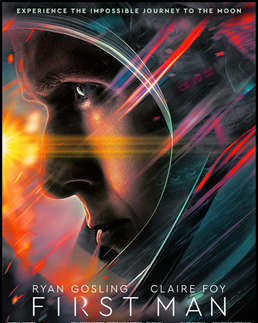I recently watched First Man, a 2018 dramatic film about astronaut Neil Armstrong and the Apollo 11 moon landing. Starring Ryan Gosling, it’s a big budget movie with great acting, beautiful cinematography, and seamless cgi to make for an immersive viewing experience. The thing that tied it all together for me though, was the soundtrack. Composed by Justin Hurwitz, it certainly bore resemblance to other space movie soundtracks, using hallmark techniques to convey the vastness of outer space. Huge, deep synthesized drones crescendoed along with impending percussive pulses in intense moments of panic, sometimes reinforced by heavy low brass reminiscent of Holst’s The Planets suite. These are all techniques that master film scorer Hans Zimmer uses in films like Interstellar. A Space Odyssey and Star Wars also use some of these in the brass minus the synthesization.
Unlike other space soundtracks I’ve heard, however, Hurwitz added a certain humanness to the score with delicate strings and harp. And unlike some other space movies, First Man is really about humanizing Neil Armstrong, tackling his personal relationships, mental health struggles, and emotions rather than just focusing on scientific, calculated space travel, rockets, and engineering. This brought a really nice balance to the soundtrack as a whole. Hurwitz knew when to employ more traditional space scoring sounds in more traditional space scenes, but also when to shift the sound to soft harp arpeggios, strings and sometimes light upper woodwinds in more intimate moments.
Another touch I loved was the use of theremin in these moments. Theremin is an electronic musical instrument controlled without any physical contact, but rather by interacting with the instrument’s electromagnetic field in two planes to control pitch and volume. It is strongly associated with aliens and space, and while you may not have heard the name, I can almost guarantee you have heard the sound at some point as an alien appeared on screen. However, Hurwitz brilliantly repurposes the theremin in the intimate scenes of the film. He is able to use it softly and delicately to yield a truly beautiful sound that is a far cry from its typical use to convey the weird and bizarre.
While the soundtrack is almost entirely original cinematic music, it does tastefully use one pre-recorded song from 1947 called “Lunar Rhapsody” by Samuel Hoffman. It obviously fits the theme of the film given the title of the song and helps to place the setting back in the early 1960s with its old-timey recording sound. It has no lyrics, but does use vocals in that classic, nostalgic mid-20th century vocal harmony. Despite this, it actually integrates pretty well into the rest of the soundtrack. I wouldn’t be surprised if Hurwitz drew some inspiration from this song for the delicate moments of his composing, with its use of harp and strings. The upper vocals even sound reminiscent of a theremin at times. It is a really beautiful and nostalgic piece and I think it was a great choice for an addition to the soundtrack.
First Man has joined the ranks of my favorite movie soundtracks. It beautifully fits the film, and I applaud Hurwitz. You can stream First Man on Netflix or stream the soundtrack on any music streaming service.
